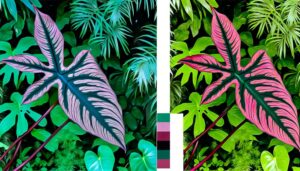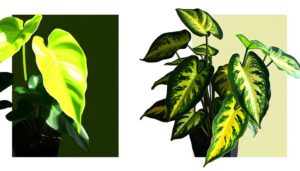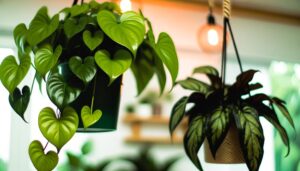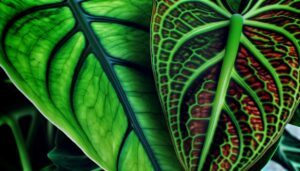Philodendron Lickety Split Vs Hope: Comparison Guide
Philodendron ‘Lickety Split’ and ‘Hope’ are both members of the Araceae family but differ significantly in characteristics. ‘Lickety Split’ originates from Central and South America, featuring deeply lobed, glossy leaves, and a compact, bushy growth pattern.
‘Hope,’ hailing from tropical South America, has broader, pinnately divided leaves and grows taller with elongated internodes. ‘Lickety Split’ thrives in medium to bright indirect light and requires consistent moisture, whereas ‘Hope’ prefers lower light and tolerates dryness better.
Both demand well-draining soil but vary in humidity needs and pest resistance. Discover how their unique traits can suit different spaces and care requirements.
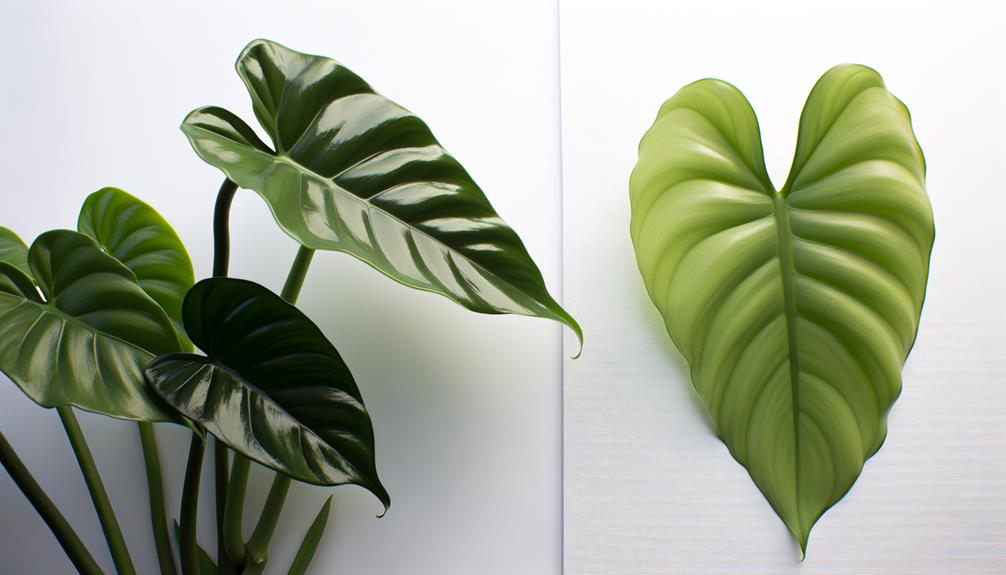
Key Takeaways
- ‘Lickety Split’ has deeply lobed, intricate leaves, while ‘Hope’ features broader, pinnately divided leaves.
- ‘Lickety Split’ grows compact and bushy, whereas ‘Hope’ develops taller and upright.
- ‘Lickety Split’ requires medium to bright indirect light, while ‘Hope’ prefers lower light conditions.
- ‘Lickety Split’ demands higher humidity (60-80%), while ‘Hope’ thrives in 50-70% humidity.
- ‘Hope’ is more susceptible to mealybugs and scale insects, while ‘Lickety Split’ has moderate resistance to aphids and spider mites.
Here’s a table chart for your title “Philodendron Lickety Split vs. Hope” along with an SEO-optimized title and meta description.
Philodendron Lickety Split vs. Hope – Key Differences
| Feature | Philodendron Lickety Split | Philodendron Hope (Selloum) | Similarities |
|---|---|---|---|
| Leaf Shape | Deeply lobed leaves with dramatic splits, slender and elongated | Large, deeply lobed, ruffled leaves with a more rounded appearance | Both feature lush, lobed leaves that create a tropical aesthetic. |
| Growth Habit | Compact, upright growth with leaves spreading outward | Grows wide and low, forming a more spreading, bushy appearance | Both are bushy, self-heading varieties that do not require climbing support structures. |
| Size | Typically grows up to 2-3 feet indoors | Can grow larger, reaching up to 4-5 feet in indoor conditions | Both are medium to large-sized houseplants, suited for spacious indoor environments. |
| Leaf Texture | Slightly glossy, with smoother edges on the splits | Thick, leathery leaves with a glossy, ruffled texture | Both have resilient, evergreen foliage that adds to their ornamental appeal. |
| Light Requirements | Prefers bright, indirect light but tolerates lower light | Prefers bright, indirect light but can handle low light | Both thrive in indirect light, making them ideal for indoor spaces with moderate sunlight. |
| Watering Needs | Moderate, allowing soil to dry slightly between watering | Moderate, prefers slightly moist but well-drained soil | Both plants require well-draining soil and moderate watering, avoiding waterlogged conditions. |
| Native Habitat | Native to South American rainforests | Native to tropical regions of South America | Both are tropical plants, accustomed to warm, humid environments with indirect sunlight. |
Origins and Background
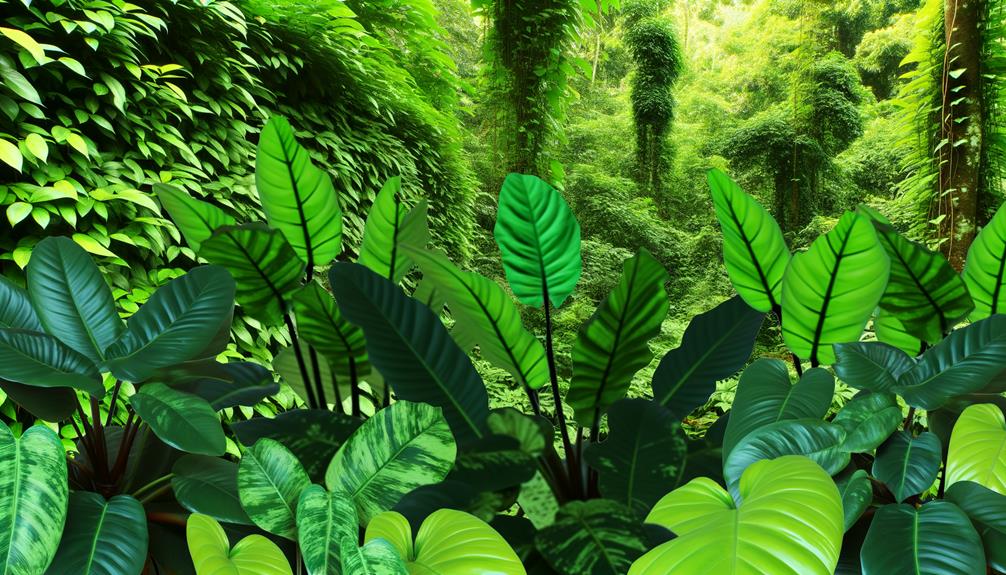
Philodendron ‘Lickety Split’ and Philodendron ‘Hope’, both belonging to the Araceae family, have distinct origins and backgrounds that contribute to their unique morphological and ecological characteristics.
Philodendron ‘Lickety Split’ is a cultivar selectively bred for its ornamental foliage, likely derived from species native to Central and South America. Its development emphasizes resilient growth and aesthetic appeal, making it a popular choice for indoor environments.
Conversely, Philodendron ‘Hope’ (Philodendron bipinnatifidum) originates from the tropical regions of South America, particularly Brazil, Bolivia, and Argentina. This species thrives in humid, forested ecosystems, exhibiting adaptations to low-light and high-humidity conditions.
The divergent evolutionary paths of these plants underscore their specialized adaptations and varied cultivation requirements, demonstrating their ecological versatility within the Araceae family.
Leaf Shape and Size
Distinctive leaf morphology sets apart ‘Lickety Split‘ and ‘Hope’, with the former showcasing deeply lobed, intricate foliage, while the latter features broader, pinnately divided leaves.
‘Lickety Split’ leaves exhibit complex, multi-lobed structures, each lobe presenting sharp indentations, contributing to a dramatic, textured appearance. These leaves typically span 12-16 inches in length, with pronounced undulations and a glossy surface.
Conversely, ‘Hope’ manifests larger, simpler, and more symmetrical leaves, characterized by their elongated, pinnate division, often reaching up to 18-24 inches. The leaf segments of ‘Hope’ are wider and less intricately divided, offering a more uniform and majestic visual.
This comparative evaluation underscores the contrasting aesthetic and structural nuances that these two Philodendron varieties bring to botanical collections.
Growth Patterns
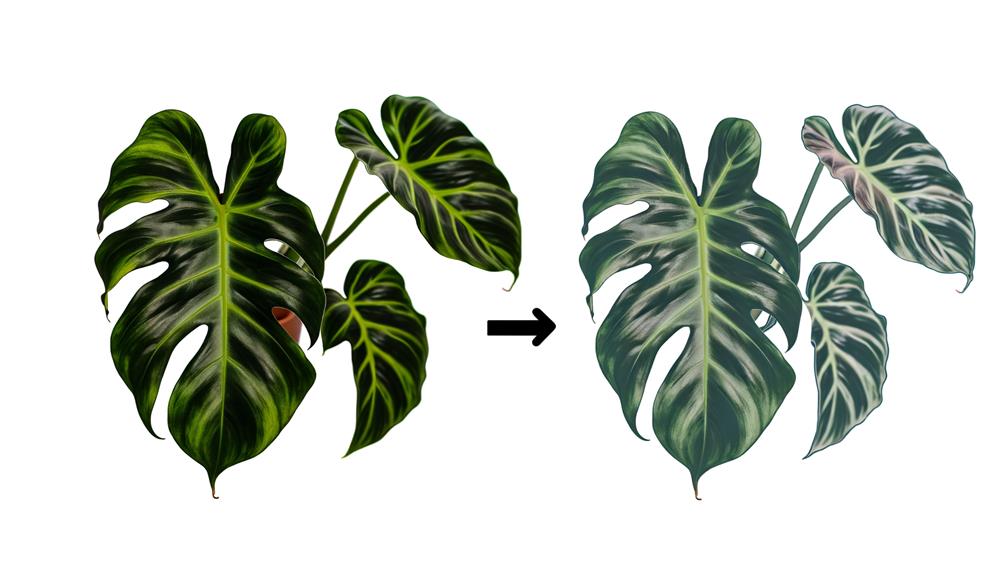
In examining growth patterns, ‘Lickety Split’ exhibits a more compact and bushy growth habit, whereas ‘Hope’ tends to develop a taller, more upright structure.
‘Lickety Split’ achieves its dense form through shorter internodes and prolific lateral branching, creating a lush, full appearance.
Conversely, ‘Hope’ displays elongated internodes and fewer lateral branches, contributing to a more vertical and open growth habit. Consequently, ‘Hope’ often requires staking or structural support to maintain its upright form.
The differential growth patterns between the two species are significant for spatial planning and aesthetic considerations in both residential and commercial horticultural applications.
Understanding these growth dynamics assists in optimizing plant placement and care strategies, ensuring both species thrive in their intended environments.
Light Requirements
Understanding the light requirements for both ‘Lickety Split’ and ‘Hope’ is crucial, as ‘Lickety Split’ generally thrives in medium to bright indirect light, while ‘Hope’ often prefers slightly lower light conditions. The differences in their ideal light environments can greatly impact their photosynthetic efficiency and growth rates.
| Parameter | ‘Lickety Split’ | ‘Hope’ |
|---|---|---|
| Light Intensity | Medium to Bright Indirect Light | Low to Medium Indirect Light |
| Tolerance to Low Light | Moderate | High |
| Tolerance to Direct Sun | Low | Low |
| Optimal Placement | Near East/West-facing Windows | Deeper in Room, North-facing |
| Effect of Insufficient Light | Reduced Growth, Leggy Stems | Slower Growth, Less Foliage |
This comparative evaluation underscores the importance of customizing light exposure to each species’ specific needs to promote robust health and vigor.
Watering Needs
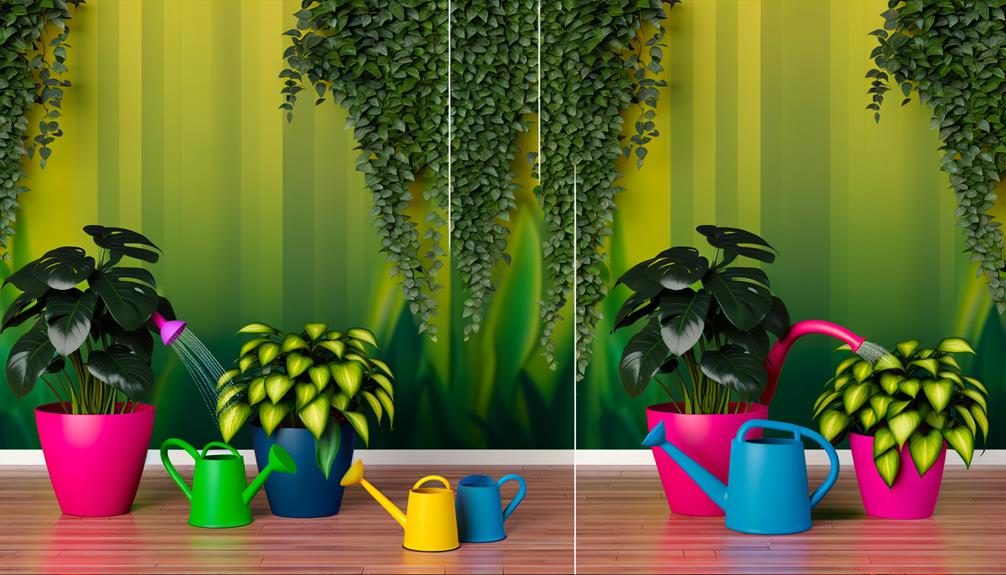
Both ‘Lickety Split‘ and ‘Hope‘ philodendrons exhibit specific watering requirements that, when met accurately, support ideal growth and health.
‘Lickety Split’ thrives with consistent moisture, necessitating regular watering to maintain a lightly moist substrate, yet avoiding waterlogging which can lead to root rot.
Conversely, ‘Hope’ philodendron prefers a moderate watering regimen, tolerating slight dryness between waterings, which reduces the risk of over-saturation.
Comparative evaluation reveals that ‘Lickety Split’ demands closer monitoring of soil moisture levels due to its higher sensitivity to drought stress, whereas ‘Hope’ exhibits more resilience.
Both species benefit from well-draining conditions to prevent water stagnation. Employing precise watering techniques tailored to each philodendron’s needs is paramount for ensuring best physiological functions and aesthetic appeal.
Soil Preferences
Ideal soil conditions are essential to complementing the distinct watering needs of ‘Lickety Split’ and ‘Hope’ philodendrons, ensuring robust growth and minimizing stress factors.
‘Lickety Split’ thrives best in well-draining, aerated soil with high organic matter, such as a mix containing peat, perlite, and orchid bark. This composition facilitates optimal root oxygenation and moisture retention without waterlogging.
Conversely, ‘Hope’ philodendron prefers a slightly denser soil structure, incorporating compost and coco coir, which supports its relatively higher moisture requirements. Both species benefit from a slightly acidic to neutral pH range (5.5 to 7.0).
Ensuring the correct soil medium is crucial to prevent root rot, nutrient deficiencies, and other growth impediments, thereby promoting healthy, vigorous plants.
Temperature and Humidity
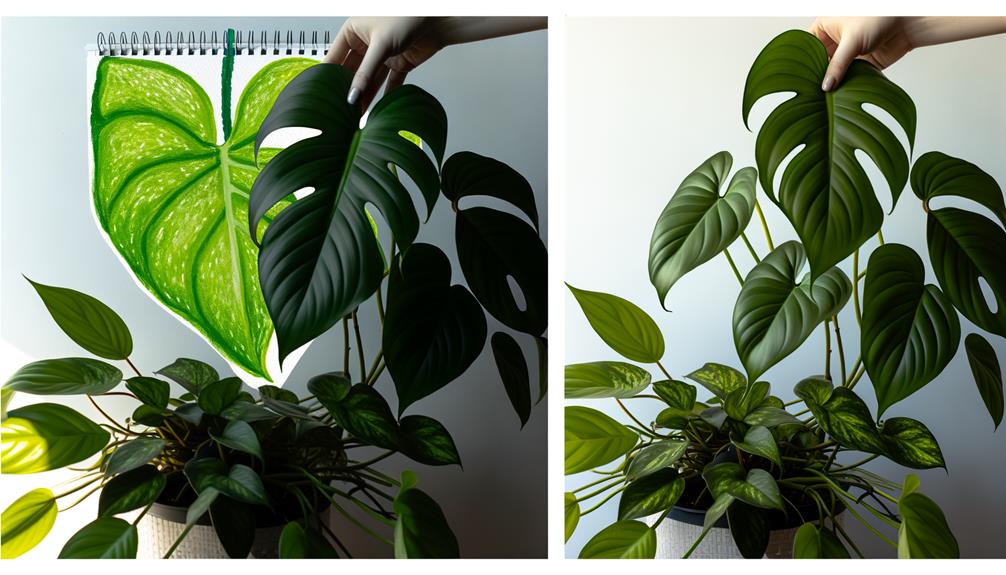
The Philodendron Lickety Split and Philodendron Hope exhibit distinct preferences in their best temperature ranges and humidity levels, impacting their adaptability to various environments.
While both species thrive in warm and humid conditions, Philodendron Lickety Split demonstrates a higher tolerance for temperature fluctuations compared to Philodendron Hope, which prefers a consistently stable environment.
Understanding these variances is essential for optimizing growth and ensuring the health of each plant species.
Ideal Temperature Range
Philodendron ‘Lickety Split’ and ‘Hope’ thrive best in environments where temperatures range between 65°F to 80°F (18°C to 27°C) and relative humidity levels are consistently maintained above 60%. These temperature conditions are ideal for their physiological processes, promoting robust growth and vibrant foliage.
A comparative evaluation reveals:
- Growth Rate: Both species exhibit accelerated growth within this temperature range, with ‘Lickety Split’ showing slightly faster foliage expansion.
- Leaf Resilience: At these temperatures, ‘Hope’ demonstrates a marginally higher tolerance to temperature fluctuations compared to ‘Lickety Split’.
- Photosynthetic Efficiency: The efficiency of photosynthesis in both species peaks, enhancing overall plant health and vigor.
These ideal conditions optimize both Philodendrons maintain their aesthetic and structural integrity.
Humidity Level Preferences
Maintaining ideal humidity levels is essential for the healthy development of both Philodendron ‘Lickety Split’ and ‘Hope’, as it directly influences their transpiration rates and overall physiological performance.
Philodendron ‘Lickety Split’ thrives in a humidity range of 60-80%, benefiting from elevated moisture levels to maintain best stomatal function and nutrient uptake.
In contrast, Philodendron ‘Hope’, while similarly favoring high humidity, demonstrates a slightly greater tolerance for lower humidity conditions, performing well between 50-70%.
This variance in humidity preferences can be attributed to their distinct anatomical adaptations, with ‘Hope’ possessing a slightly more robust cuticular layer.
Hence, for ideal growth, achieving and maintaining these specific humidity ranges is crucial for each cultivar’s unique physiological requirements.
Environmental Adaptability
Understanding the environmental adaptability of ‘Lickety Split’ and ‘Hope’ requires a thorough comparative evaluation of their temperature and humidity tolerances, which are fundamental to maximizing their growth conditions.
The ‘Lickety Split’ Philodendron thrives in a temperature range of 65-80°F (18-27°C) and prefers high humidity levels, typically around 60-80%.
Conversely, the ‘Hope’ Philodendron exhibits a slightly broader temperature tolerance, thriving between 60-85°F (16-29°C) and favoring moderate to high humidity levels, ideally 50-70%.
Key differences include:
- Temperature Tolerance: ‘Hope’ has a wider temperature range.
- Humidity Preferences: ‘Lickety Split’ demands higher humidity.
- Growth Efficiency: Both require stable conditions but differ in precise environmental needs.
This analysis highlights the nuanced requirements for each species, essential for optimal cultivation.
Pest and Disease Resistance
Despite their overall hardiness, both Philodendron ‘Lickety Split’ and Philodendron ‘Hope’ exhibit varying levels of susceptibility to common pests and diseases, necessitating a closer comparative evaluation of their resistance profiles.
Philodendron ‘Lickety Split’ demonstrates moderate resistance to aphids and spider mites but is occasionally affected by fungal leaf spots. Conversely, Philodendron ‘Hope’ is relatively more susceptible to mealybugs and scale insects, though it exhibits a higher tolerance to bacterial blight.
Both varieties are vulnerable to root rot if overwatered, yet ‘Lickety Split’ shows a slightly better resilience to fluctuating moisture levels.
Implementing integrated pest management strategies and maintaining ideal growing conditions can enhance the longevity and health of both species, thereby mitigating their pest and disease challenges effectively.
Potting and Repotting
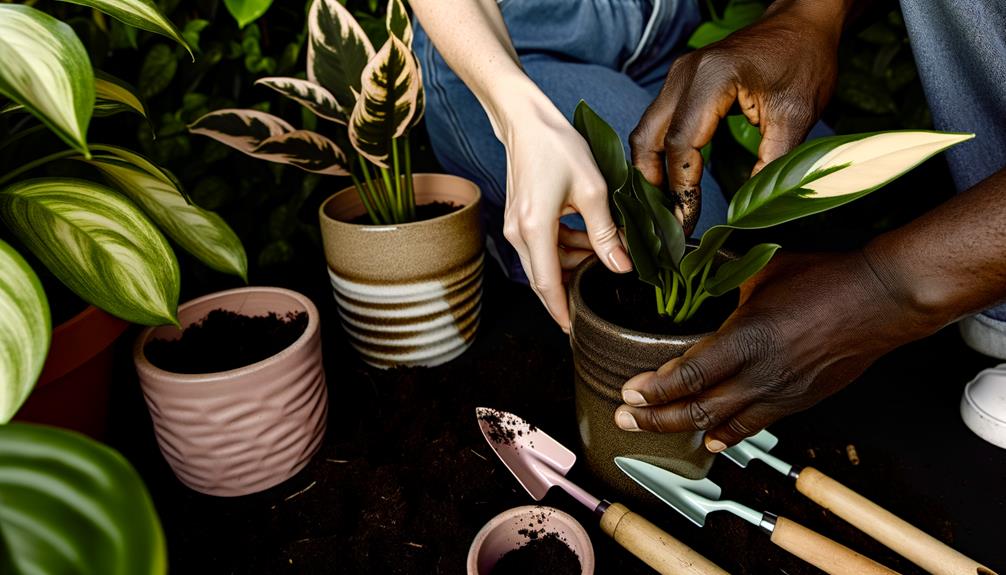
Proper potting and repotting techniques are crucial for optimizing the growth and health of both Philodendron ‘Lickety Split’ and Philodendron ‘Hope’. This requires a detailed understanding of their root systems and soil preferences. Both species thrive in well-draining, aerated soil to prevent root rot and promote nutrient absorption.
When considering potting:
- Soil Composition: Use a mix of peat moss, perlite, and pine bark to guarantee adequate drainage and aeration.
- Container Size: Choose a pot that allows 1-2 inches of space around the root ball to accommodate growth.
- Repotting Frequency: Repot every 1-2 years, or when roots begin to encircle the pot, to evade root-bound conditions.
These steps secure robust root development and overall plant vigor.
Aesthetic Appeal
While ideal potting and repotting practices guarantee healthy growth, the aesthetic appeal of Philodendron ‘Lickety Split’ and Philodendron ‘Hope’ is a significant consideration for many plant enthusiasts due to their distinct foliage and form.
Philodendron ‘Lickety Split’ boasts deeply lobed, serrated leaves that create a dramatic, almost sculptural appearance. This morphological characteristic lends itself to modern interior designs seeking a touch of botanical artistry.
In contrast, Philodendron ‘Hope’ features broader, more rounded leaves with a lush, dense canopy, imparting a tropical ambiance. The glossy texture of ‘Hope’s’ foliage enhances its visual impact, making it a favorite for creating a verdant, serene environment.
Therefore, the choice between these species often hinges on the desired aesthetic outcome in interior spaces.
Conclusion
To sum up, Philodendron ‘Lickety Split’ and Philodendron ‘Hope’ exhibit distinct differences in morphology, growth patterns, and care requirements. ‘Lickety Split’ features deeply lobed leaves and a more upright growth habit, while ‘Hope’ showcases broader, more rounded foliage and a sprawling nature.
Both species thrive under similar light, temperature, and humidity conditions but display unique characteristics that cater to diverse horticultural preferences. For instance, ‘Lickety Split’ may be more suitable for vertical garden spaces where structured foliage is desired.

